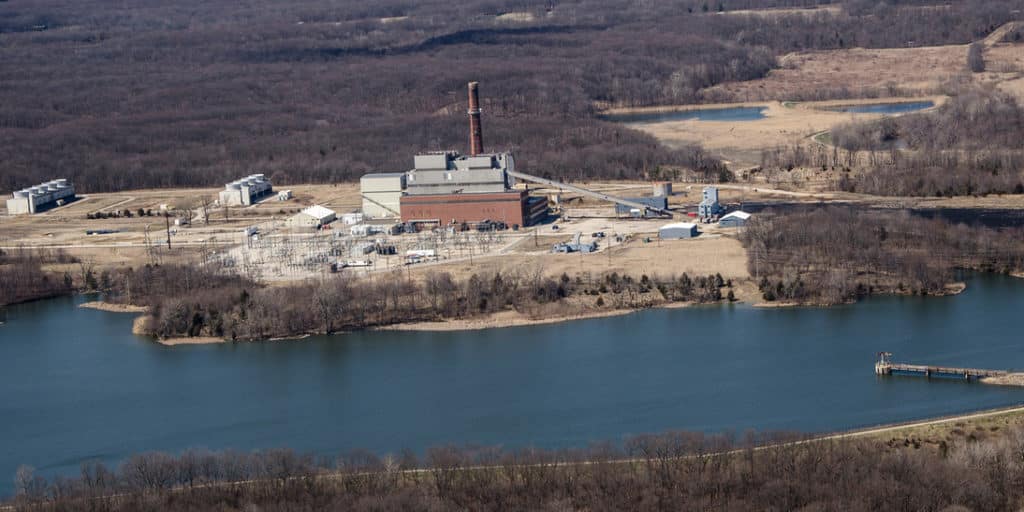
Quick Facts: Listen to an Interview or Download a Flyer
Contents
- Overview
- What is Coal Ash?
- What are the Ash Pits?
- Middle Fork River; What is at Risk?
- What is Dynegy’s Plan for the Pits?
- Groundwater Violation Timeline
- History of the Site
- Vermilion County Passes Resolution
- US EPA Coal Ash Rules and Vermilion
- Reference Documentation
Overview

Community members have long been concerned about the coal ash stored at the Vistra (formerly Dynegy) Vermilion Power Plant in Oakwood, Illinois. The coal-fired power plant operated from 1955 through December 2011, dumping coal ash (a toxic by-product from burning coal) in three ash pits — all located in the western floodplain of the Middle Fork of the Vermilion River, Illinois’ only National Scenic River.
The site presents three major issues: (1) ongoing pollution of groundwater that runs beneath the pits, and at points running through the pits; (2) pollution of the Middle Fork through seeps which are hydrologically connected to the buried coal ash; and (3) the risk of a catastrophic breach, where massive amounts of coal ash could inundate the Middle Fork.
The two oldest ash pits (constructed in the mid-1950′s and 1970′s, respectively) were built without liners to protect underlying groundwater. Adding additional risk, the river is rapidly meandering towards the pits at rates as high as three feet per year. Leakage of coal ash pollutants (including boron, sulfates, iron, and manganese) has already been noted in the groundwater, while discolored seeps can be readily seen from the river.
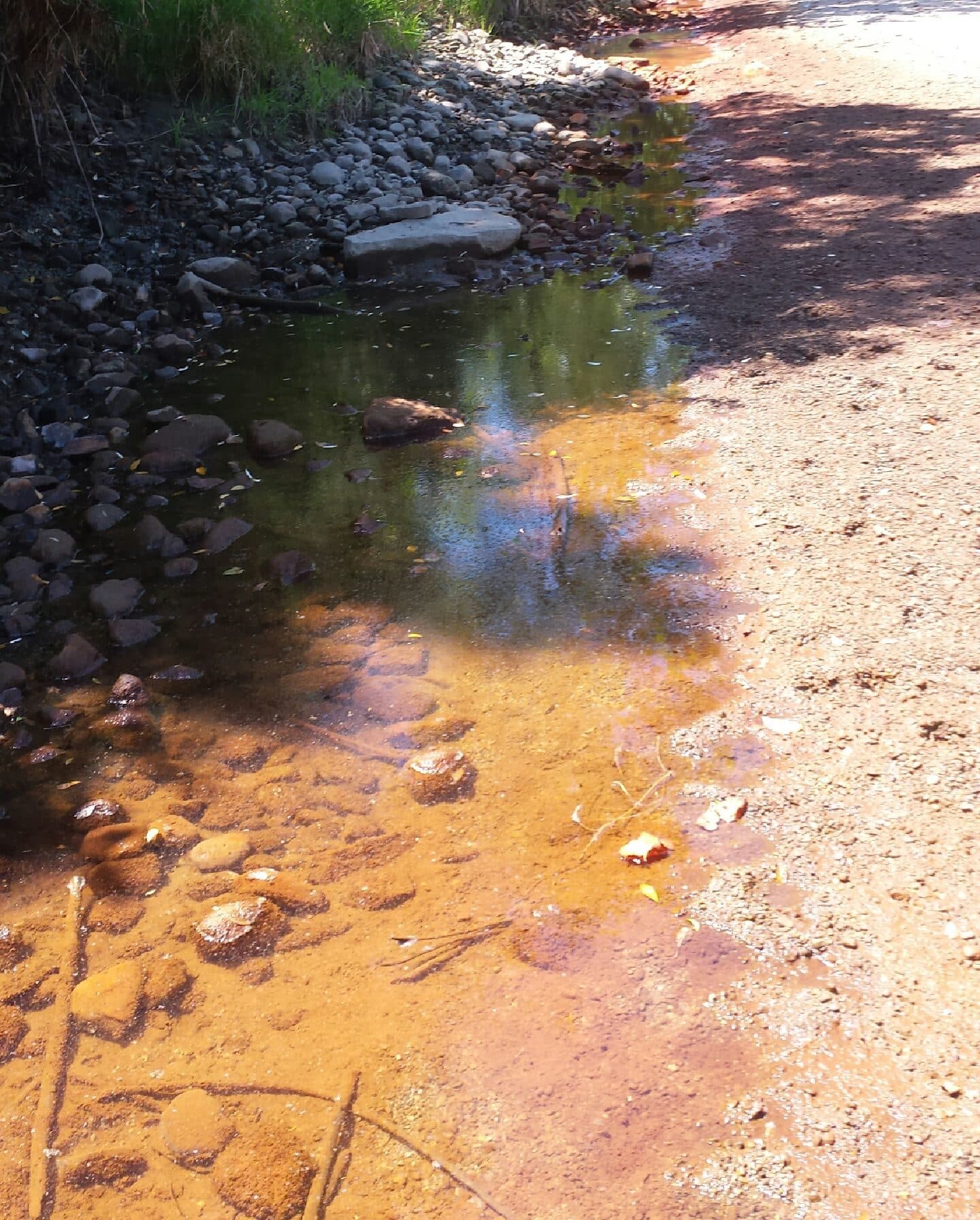
Click here to see a video of the seeps.
The third newest pit (constructed in the 1980′s) presents problems of its own. The third pit was constructed over old mine voids. These mine voids present risks of subsidence – indeed Dynegy’s own report indicate that portions of the shale over the mine have been shattered by mine void collapse. The third pit relies on this shale as a natural liner, so breaking of the shale could open pathways for contamination. Additionally, like the two older ash pits, the third pit has been worn by the force of the river, presenting a risk to its stability. The site was subject to emergency bank stabilization to prevent the river from eroding the impoundment in 2016.
Dynegy has proposed to simply cap these pits and walk away from the liabilities. This proposal would leave the coal ash in place at the dump site, with only a cap over the pits to prevent additional water from getting in from above. This plan would allow groundwater contamination and seepage to the river to continue in perpetuity, while failing to address the threat of a catastrophic breach.
Leaving coal ash in the floodplain, vulnerable to the force of the river, with the proposed “cap closure option” for the impoundments is not sufficient to protect local residents, businesses, and Illinois taxpayers from the burden of ongoing pollution and a potential breach.

In order to protect the vibrant Middle Fork river system and the communities that rely on it, Prairie Rivers Network has announced their intent to sue Dynegy for clean water act violations.
Dynegy is responsible for the coal ash mess on the banks of the river and needs to stop polluting the Middle Fork. The long-term conservation of this land is important for the benefit of Illinois’ citizens and wildlife.
What is Coal Ash?
Coal ash is the solid by-product that is left over after coal is burned for electricity — much like ash is left over after burning wood in a fire.
Coal ash, also referred to as “Coal Combustion Residuals” (or CCRs), broadly refers to several by-products:
- Fly Ash: a very fine, powdery material made from the burning of finely ground coal in a boiler
- Bottom Ash: a coarse, angular ash particle that is too large to be carried up into the smoke stacks, so it forms in the bottom of the coal furnace
- Boiler Slag: molten bottom ash
- Flue Gas Desulfurization Material: leftover from the process of reducing sulfur dioxide emissions from a coal-fired boiler that can be a wet sludge
When coal is mined, it already contains carbon alongside a number of heavy metals and minerals — including mercury, arsenic, selenium, chromium, and cadmium, which can cause cancer and brain damage in humans and are harmful to fish and wildlife.
When coal is burned, much of the carbon burns off (combining with oxygen to produce Carbon Dioxide, or CO2). What’s left (coal ash) has these same metals that were there all along, but now at 10-100x higher concentrations.
What are the Ash Pits?
There are three ash pits at the Dynegy Vermilion facility: (1) the North Ash Pond System; (2) the Old East Ash Pond; and (3) the New East Ash Pond System. Also called “ash ponds” or “ash impoundments,” these are disposal sites formed by perimeter earthen embankments.
These pits contain a mix of coal ash materials (including fly ash, bottom ash, boiler slag, and other materials) with different chemical compositions (because of different types of coal burned over the power plant’s lifetime).
Images of the seeps are available on this map:
North to south, the three ash pits are:
(1) The North Ash Pond System (one large pit for disposal, another smaller pit for sedimentation of overflow) was utilized from the mid-1970′s to 1989.
- Unlined
- In the Middle Fork floodplain (subject to erosion)
- Total Volume: 1,618,335 cubic yards
(2) The Old East Ash Pond was put into service in the mid-1950′s and operated until the mid-1970′s.
- Unlined
- In the Middle Fork floodplain (subject to erosion)
- Total Volume: 1,183,413 cubic yards
(3) The New East Ash Pond System (one large pit for disposal, another smaller pit for sedimentation of overflow) was utilized from 1989 until the plants closure.
- Natural shale “liner”
- In the Middle Fork floodplain (subject to erosion)
- Located over mine void (subject to subsidence: sinking of the land)
- Total Volume: 534,013 cubic yards
The total volume of the pits is 3,335,761 cubic yards. For some context, the total volume could fill New York City’s Empire State Building 2.4 times, or over 1000 Olympic swimming pools.
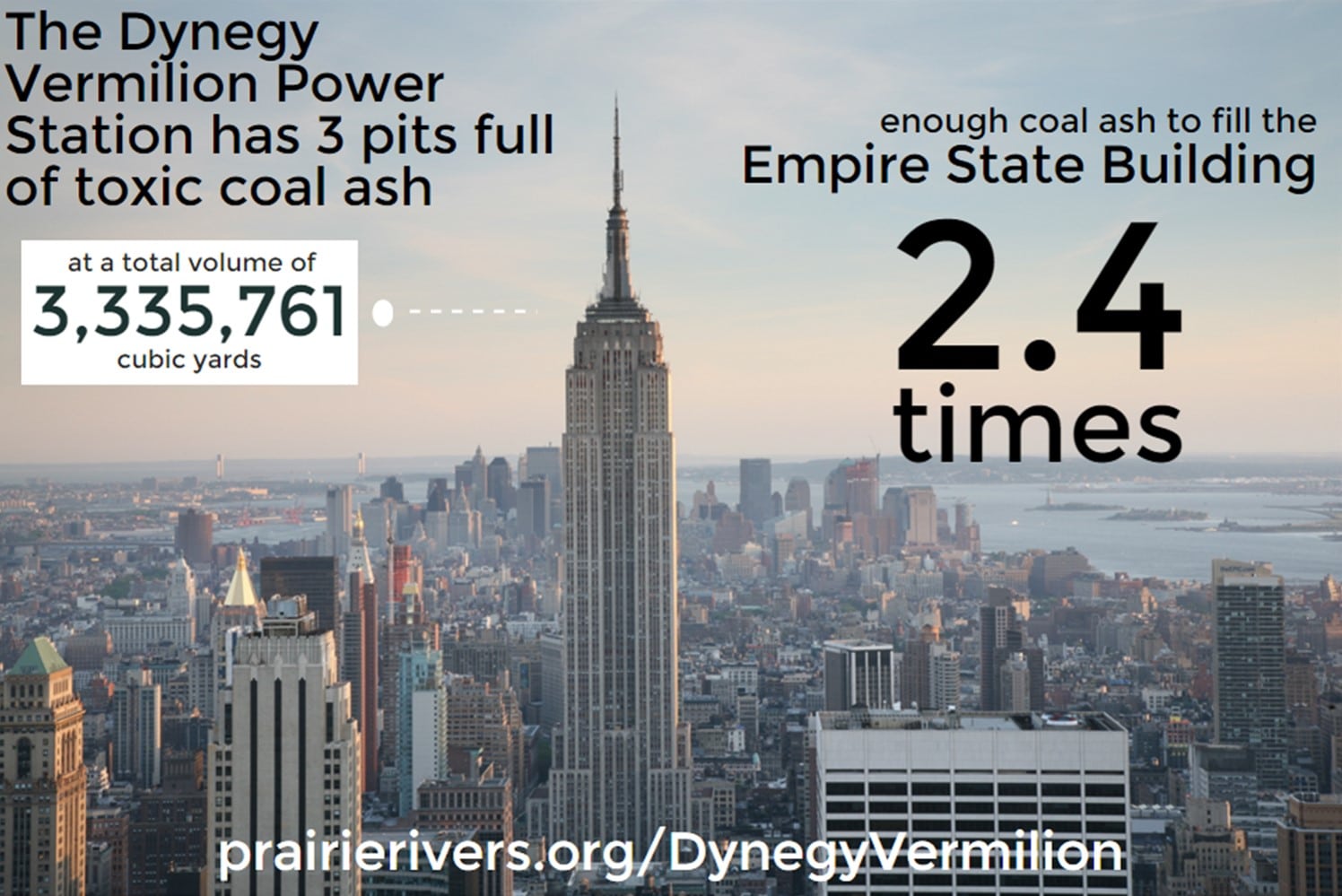
Dynegy’s own reports state that the pits are now contaminating the groundwater and that groundwater is flowing toward the Middle Fork. There are already visible seeps along the bank, and detectable impacts in the water and aquatic life. This means that heavy metals in coal ash are currently placing the Middle Fork and adjacent groundwater at risk.
As the Middle Fork of the Vermilion River continues to wear away at the sides of these pits, the threat of a catastrophic breach continues to increase.
Middle Fork River: What is at Risk?
The Middle Fork of the Vermilion River is a unique and cherished resource. The river been was the first state-designated State Scenic River, and is the only nationally-designated Scenic River in the state of Illinois.

In legislation, the Illinois General Assembly stated that it “recognizes the outstanding natural, scenic, recreational, ecological, historical and archaeological values of the middle fork of the Vermilion River in Vermilion County, Illinois, and deems the middle fork of the Vermilion River to be a natural resource of Statewide significance such that its natural and recreational values should be permanently preserved for the enjoyment of the people of the State of Illinois.”
The Middle Fork River Valley is home to 24 State threatened or endangered species, and supports a diverse and healthy population of 57 types of fish, 45 kinds of mammals, and 190 different birds. It’s common to see turtles, river otters, blue herons and bald eagles on a trip down the river.
The river system also provides the benefits of a strong recreation economy to Vermilion County. Kickapoo State Recreation Area, Kennekuk Cove County Park, and the Middle Fork State Fish and Wildlife Area stand as key destinations for local residents and visitors , enjoyed for canoeing, kayaking, wildlife viewing, photography, hunting, angling, hiking, and horseback riding.
According to a publication of the University of Illinois Springfield, in 2009 Kickapoo State Recreation Area, alone, hosted 1,458,491 visitors. Kickapoo Landing alone puts over 10,000 people on the Middle Fork River in canoes, kayaks and tubes each year.
It is clear that the unstable and polluting Dynegy ash pits are putting this unique resource at risk. As the state of Illinois recognized in its Corridor Management Plan, it must “work toward abatement of activities within the river area which are degrading water quality.”
What is Dynegy’s Plan for the Pits?
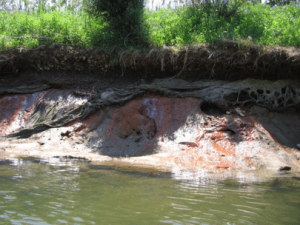
Dynegy is currently proposing to leave the ash in its current location and cover the site with a “cap” (2.5 inches of a geomembrane and 15 inches of a geocomposite, then 3 feet of soil).
This method attempts to address just one source of ongoing pollution: as rainwater and snowmelt continues to enter the pits, it contributes to the movement and leaching (seeping) of contaminants.
This fails to acknowledge:
- That seeps and pollution are already occurring because of contact with groundwater (which runs through and saturates the pits, connecting to the river),
- That flash flood pressure and erosion from the meandering river can wear away at the pits from the outside, and
- That the river pushes water into the pits during flood events, which slowly seeps back out with contaminants
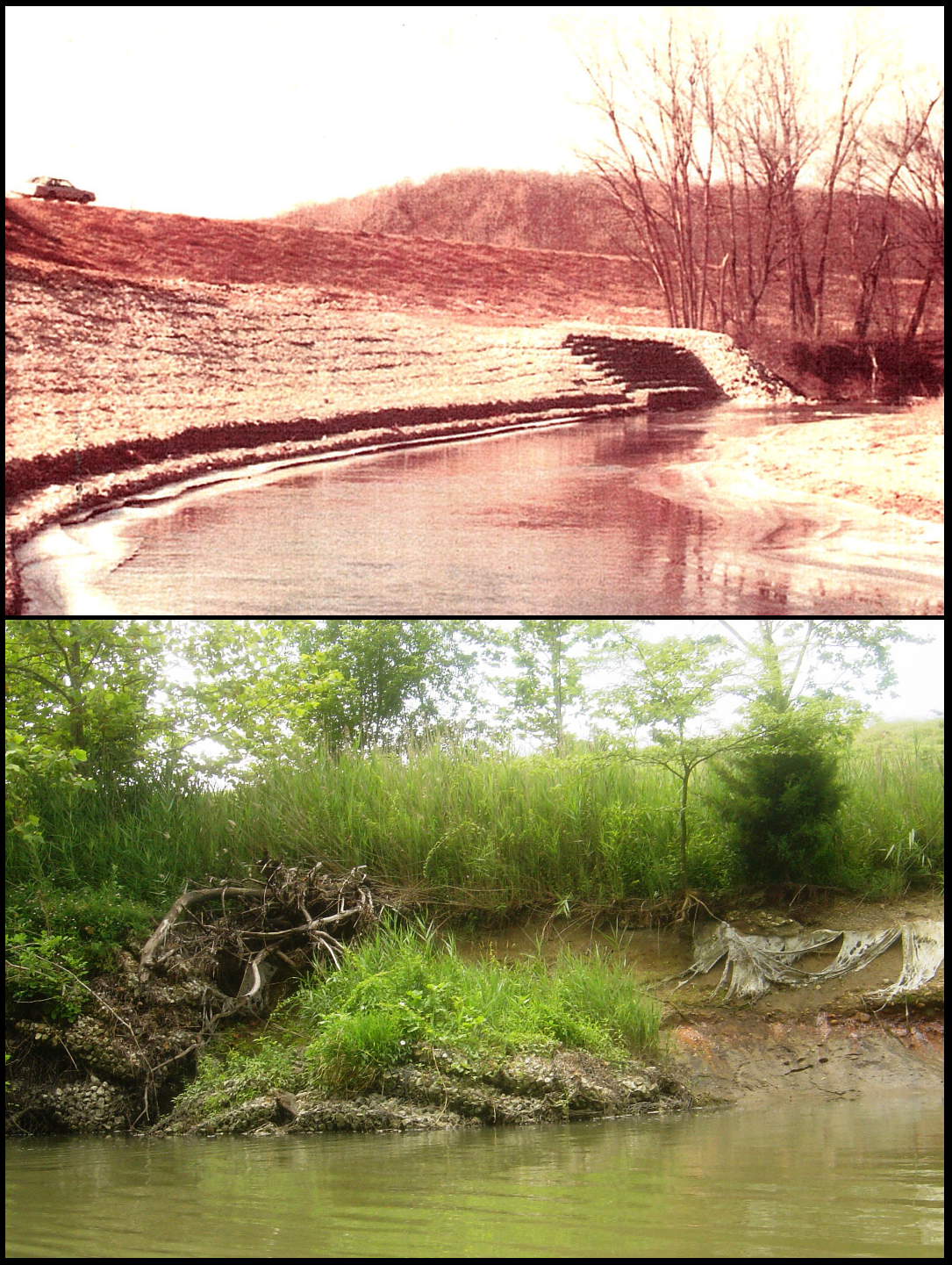
Below) Failed gabions in the present day.
To prevent river bank erosion, Dynegy’s predecessor installed gabion walls (cages filled with rocks) to armor a portion of the river bank in the 80s. These gabions, once impressive, are now sitting neglected and in ruin, worn away by the power of the river. Bank reinforcement is not a long term solution to preventing the Middle Fork river from eroding into the coal ash.
As of 2018, Dynegy has released a new report that shows the Middle Fork is eroding the river bank at an alarming rate – up to 3 feet each year. This new report comes after Prairie Rivers Network frequently criticized their previous report which estimated that the erosion rate was one third of a foot per year.
Acknowledging these threats, and the risks to the Middle Fork ecosystem and local economy, Dynegy needs to permanently protect the Middle Fork River so the river may be enjoyed for generations to come.
Groundwater Violation Timeline
Dynegy received a groundwater violation notice in 2012 that kicked off a regulatory process that is ongoing to this day. They have yet to fully characterize the site or propose a plan that will adequately deal with the problem.
The timeline below was constructed through FOIA requests for public records. It represents the record available to Prairie Rivers Network staff at this time. Relevant documents are linked.
2012 – July – Dynegy receives a notice of groundwater violation
- Illinois EPA issues a violation notice to Dynegy indicating that groundwater quality samples at the at the Vermilion Power Station (and many other sites) have violated multiple groundwater standards.
- The letter and violation notice.
2012 – September – Dynegy responds to groundwater violation
- Dynegy responds to the violation notice with a Compliance Commitment Agreement which, in this case, consists of a closure plan for the Old East Ash Pond and North Ash Pond System. Additionally, Dynegy proposes a Groundwater Management Zone, which would give them permission to violate groundwater standards while they implement a solution.
- Links to Dynegy’s letter to Illinois EPA, closure action plans for OEAP and NAPS, as well as the Groundwater Management Zone application.
2012 – October – Dynegy’s proposed compliance commitment agreement is rejected
- The letter.
2013 – March – Dynegy proposes a geotechnical study
- The proposed study would assess the stability of the coal ash impoundments and the erosion rate of the river bank.
2013 – May – Dynegy is given permission to move forward with the geotechnical study
- The letter giving permission for the study, which also reference the letter in which Dynegy proposes the study (which is missing).
2013 – November – Dynegy sends the geotechnical study to Illinois EPA
- The study concludes that the North Ash Pond System will fail in 86 years.
- The letter and the geotechnical report.
2014 – September – Dynegy’s study is found to be insufficient
- Illinois EPA finds Dynegy’s geotechnical study to be insufficient and requests more studies to address erosion concerns.
- The letter.
2015 – June – Dynegy refuses to do further studies until riverbank stabilization is approved
- Dynegy refuses to do further studies until riverbank stabilization projects are approved. At this point, Dynegy has only applied for stabilization at the New East Ash Pond, which is the one coal ash impoundment at the site that is not part of the closure plans, so the refusal seems unrelated.
- The letter.
2016 – November – Dynegy completes a bank stabilization project on the New East Ash Pond
- Dynegy is given permission from the US Army Corps of Engineers, Illinois EPA, Illinois DNR, and the National Park Service, to complete a bank stabilization project on the New East Ash Pond due to alarming amounts of erosion. This project does not impact the Old East Ash Pond or North Ash Pond System.
- Dynegy’s completion report for the stabilization project.
2017 – February – Dynegy is again requested to do additional studies
- Illinois EPA circles back to Dynegy now that they have had an approved bank stabilization project. They are asked to address the bank erosion problems and prepare a new closure alternatives assessment.
- The letter.
2017 – May – Dynegy submits a new plan for studies to Illinois EPA
- Dynegy submits a new plan and timeline for studies to Illinois EPA. They will re-assess the closure plans and the groundwater study, as well as the bank stabilization. The reports will be submitted near the end of 2017.
- The letter.
2017 – November – Dynegy submits a new bank erosion report and closure cost estimate to Illinois EPA
- The new river bank stabilization report was submitted on November 6 to Illinois EPA, showing that river bank erosion is much faster than previously reported.
- The new closure cost estimates were submitted on November 30.
2018 – January – Illinois EPA requests clarifying details on closure cost estimates
- In an email, Illinois EPA requests additional closure cost estimate details from Dyengy, specifically about investigating an on-site closure option.
2018 – June – Illinois EPA issues second violation notice. Dynegy/Vistra proposes armoring the river bank
- Illinois EPA inspected the coal ash seeps in May 2018 and determined that the seeps were in violation of the Illinois Environmental Protection Act, issuing a second violation notice.
- Vistra, who now owns Dynegy, proposed 1900 feet of bank armoring, which would cover most of the river bank of the North Ash Pond System and Old East Ash Pond.
- The 2012 groundwater violation is still unresolved.
History of the Vermilion Power Station
The closed power station is located about five miles north of Oakwood, Illinois. It sits on a bluff above of the river valley, but coal ash was dumped into the valley for its entire operating life.
1950′s
- The Vermilion Power Station was built and put into operation by the Illinois Power Company in 1955
- The Old East Ash Pond (OEAP) was part of the original construction of the plant.
1970′s
- The OEAP remained in operation until the mid-1970′s when the North Ash Pond System (NAPS) was brought online
1980′s
- Gabions were installed in 1981 to protect the Old East Ash Pond impoundment
- The NAPS was actively receiving waste from the mid-1970′s to 1989, when the New East Ash Pond System (NEAP) was brought online
2000′s
- Dynegy purchased Illinois Power in 2000, and acquired the Vermilion Power Station as part of the purchase
- Dynegy applied for a bank stabilization permit to install gabions along the east side of the NEAP in 2009, which was not approved
2010′s
- The plant closed on November 19, 2011, and the NEAP became inactive
- All ash ponds are now “out-of-service,” but not fully “closed”
Vermilion County Passes Unanimous Resolutions
In the absence of existing rules to regulate the comprehensive closure of sites like Dynegy Vermilion, Vermilion County groups stepped up to encourage stronger rules at the state level and additional consideration for closure of ash pits at the Dynegy Vermilion facility.
In 2014, a series of resolutions passed unanimously by the Vermilion County Board, Soil & Water Conservation District, Vermilion County Conservation District, Vermilion County Conservation Foundation, and the Lake Vermilion Water Quality Coalition, calling on the Illinois Pollution Control Board to address regulatory shortcomings, and on the Illinois Environmental Protection Agency to address management and public participation issues as they apply to the Dynegy Vermilion closure plan.
What about the U.S. EPA Coal Ash Rules?
On October 19th 2015, the U.S. EPA’s new safeguards on the disposal of coal ash went into effect nationwide. The rules are targeted to prevent impoundment failures (like the massive Kingston, Tennessee spill in 2008), protect groundwater beneath coal ash disposal sites, and establish basic requirements for maintaining these massive waste storage pits.
Unfortunately, legacy impoundments — the old, polluting pits like Dynegy Vermilion, storing tons of coal ash next to our rivers, lakes, and streams — are left largely unregulated. Illinois is home over 80 coal ash pits, some of which are located at now-shuttered power generating facilities. Dynegy is planning to close nearly all of its coal ash pits in place with a cap, forever exposed to groundwater.
We believe the federal rule should be expanded to include legacy pits like these. But if it is not, then these pits will need Illinois-specific rules to protect the surrounding communities and water ways. These rules were in once motion, but have been frozen in front of the Illinois Pollution Control Board for over a year, and the latest proposed rules from Illinois EPA lacked key safeguards to creating real solutions for coal ash pits (i.e., power plant operators who could easily leave the damages for communities to pay).
Reference Documentation
All documents listed here are linked to directly when referenced above.
- Hydrogeologic Study of New East Ash Pond, 2003
- Old East Ash Pond Closure Plan, 2012 (Updated in 2014)
- North Ash Pond System Closure Plan, 2012 (Updated in 2014)
- Groundwater Management Zone application, 2012
- First Geotechnical Report, 2013
- Second Geotechnical Report, 2017
- Closure Cost Estimate, 2017
- Bank Armoring Proposal, 2018


